Rock climbing has long been thought of as an outdoor, extreme sport, but more and more, people are starting to realize the physical and mental health benefits of climbing. Indoor climbing gyms are rapidly on the rise and are not geared toward only adrenaline junkies – the sport is suitable for people of all ages, fitness level, and experience. All that’s needed is some preparation, as well as some research beforehand.
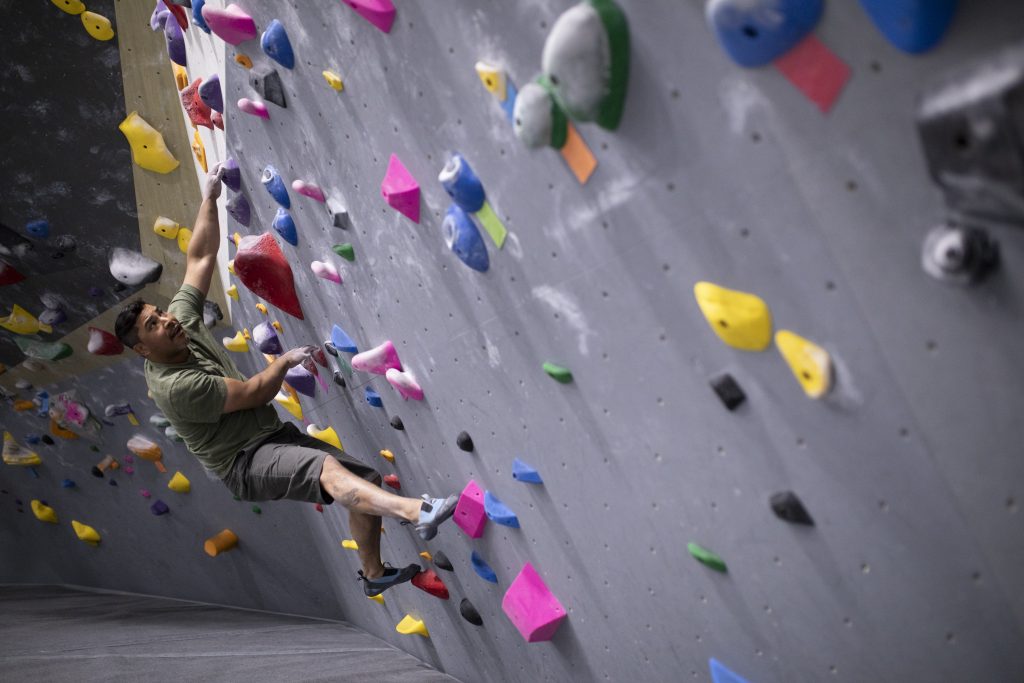
So, if you’re interested in learning more about this sport, you’ve come to the right place. We’ll discuss all you need to know about rock climbing, including the different types of climbing, the benefits of it, the gear you’ll need, the common etiquette, jargon, and more.
Click here to jump to a specific section:
Styles of Indoor Rock Climbing
Routes Grades
Benefits of Rock Climbing
Gear
Etiquette
Jargon
Different Holds
Falling
Basic Climbing Technique
Preventing Injuries
Managing Injuries
The Lowdown
Generally speaking, rock climbing is a sport that includes climbing up, across, or even down a natural or artificial rock formation. While outdoor rock climbing is considered a high-risk activity (which is why investing in specialized gear is a must if you’re interested in taking it up as a sport), indoor rock climbing offers a healthy dose of adrenaline in a very safe environment.
Climbing gyms offer multiple varieties of climbs designed to emulate different facets of outdoor climbing which can be further broken down into subcategories.
Styles of Indoor Rock Climbing
Bouldering
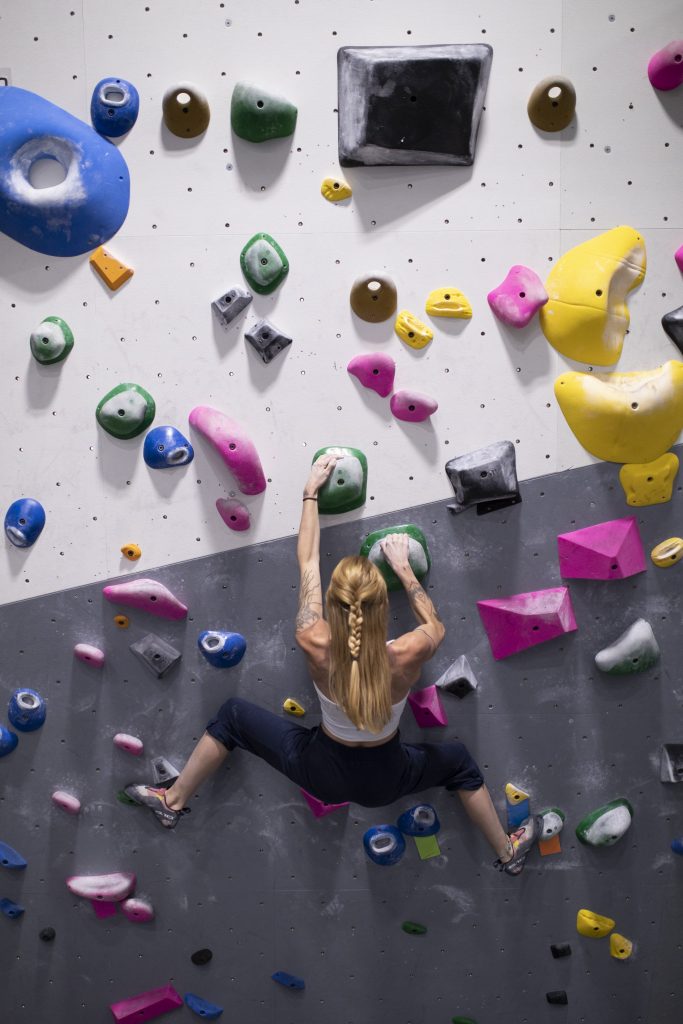
Bouldering is climbing in its simplest, most raw form, without ropes and harnesses. Many beginners start with bouldering because the routes, called “problems,” are typically on smaller walls or rocks – the shorter height (usually less than 15 ft) is less daunting than other climbing disciplines which can have routes 30-60 ft high indoors.
However, bouldering should not be confused to be “for beginners only.” The problems are short and intense, and some can be so difficult, like a V14 (more on grades later), that only a handful of exceptionally strong climbers can complete them. Hard bouldering problems concentrate difficulty in a relatively short span forcing climbers to visualize, problem solve, and adapt immediately. The difficulty of individual moves can work climbers at the limits of their strength, coordination, and balance with a combination of demanding, and often dynamic sequences, short lines, and mental complexity.
Bouldering doesn’t require much gear, and, though it’s always more fun with friends, it doesn’t require another person. So you can put on some climbing shoes, chalk up, and get on that wall. Most gyms make it easy to identify the right climbs for your level with the color codes. Simply find the grading chart at the gym, choose the color that corresponds to the difficulty that is appropriate for you, and try the climbs in that color until you want to progress to more difficult climbs.
Sport Climbing – Top Roping
Top roping routes are usually much higher (up to 60 ft) than bouldering problems, but because the climber is attached to an anchored rope, it is one of the safest climbing styles. The rope is attached to the climber wearing a harness and is fed through a pulley system anchored at the top of the wall. The other end of the rope is controlled by a partner, or belayer, who takes up slack as the climber ascends. The rope does not assist the climber, but is a safety line in case of a fall. It is also used to lower the climber from the top or allow him/her to rest during the climb.
Some indoor climbing gyms also offer auto-belays which are anchored to the top of the wall and will gently lower a climber off the wall, eliminating the need for a belay partner.
The height can be somewhat dizzying, and first time top ropers may have some difficulty with a 50 foot trust exercise (falling from a chair and trusting coworkers to catch you is one thing – from the top of your office building is quite another). Getting over this fear is a part of climbing and becomes part of the thrill. The belay system works so well that top roping is one of the safest and most popular forms of indoor climbing.
Sport Climbing – Lead
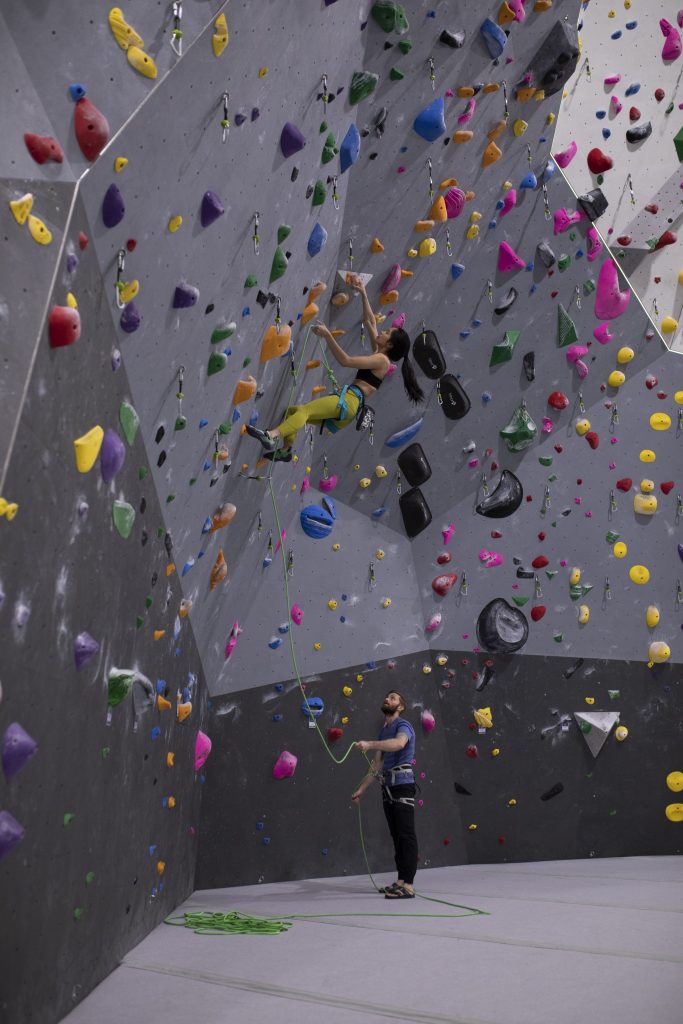
Lead climbing is somewhat similar to top roping in that a rope, harness, and belayer are required, but that’s where the similarities end. Lead climbing is the next level with longer falls. One end of the rope is tied to the lead climber, who clips in to a series of quickdraws (carabiners attached to bolts on the wall) spaced apart along the route. The climber clips in as he/she progresses through the route. In the event of a fall, the lead climber will drop just beyond the previously clipped quickdraw including any slack on the rope, generally 3 – 6 feet. Scrapes and bruises are common, and inexperienced climbers can suffer greater injuries.
This style of climbing is a much better real-life emulation of outdoor climbing since an anchor point at the top of a route is not typically available.
Many gyms offer training classes or guidance for beginners and may require certification, so make sure to ask the gym staff before attempting to lead climb. Specific techniques, such as proper clipping and belaying are crucial for having a safe and fun experience.
Speed Climbing
Speed climbing is a true adrenaline rush. As the name would suggest, the goal of speed climbing is to finish the climb as quickly as possible, so you can imagine how exciting speed climbing competitions can be. Unlike other disciplines, speed climbing is a competitive race between two climbers rather than an individual against the route. Two climbers race along the same route, side by side; the time begins when the climber’s feet leave the sensor on the ground and ends when he/she taps the sensor on the top. The world record (as of 2017) for a 15 meter climb in the blink of an eye at 5.47 seconds (which is probably faster than I can run 15 meters).
Unlike other styles, speed climbing routes are standardized and do not change from competition to competition allowing climbers to focus on speed rather than figuring out the best way to climb the route.
Routes Grades
Route grading systems are difficult to understand and factor in that many are subjective, and you can find yourself easing through a V7 one day only to repeatedly fall off a V3 the next.
There is a distinction between the scales used for bouldering and those for sports climbing. Keep in mind that scales can vary from area to area, and if your rock-climbing adventures take you to places all over the world, you’ll be sure to encounter a variety of different scales and grades. Here, we’ll focus on the systems used in the US.
Understand, but Don’t Get Hung up on It
The grades can prove to be very useful, especially so that the climbers don’t bite off more than they can chew. While some gyms make it seem like grade-chasing is the ultimate goal, this is not the case. Rock climbing is all about self-improvement – it’s about competing with yourself and working hard to master difficult moves and techniques. Grades are there to keep you informed about the estimated difficulty level, but take them with a grain of salt.
Route Grades for Bouldering – V-scale
Short for Vermin scale and used primarily in North and South America, Asia, and Australia, boulder problems go from V0, all the way up to V17, and the higher the number, the more difficult the climb. You might even encounter a VB grade in some climbing gyms, but this is used only for absolute beginners, and it’s for explaining the very basics of climbing. Think of VB as a bunny hill for climbing.
Route Grades for Sports Climbing – YDS
Short for Yosemite Decimal System and predominantly used in the USA, YDS is used to grade many outdoor activities like hiking, scrambling, and climbing. YDS is separated into classes, so while hiking would fall into class 1, climbing is in class 5. The decimal following the class number specifies the difficulty level.
For climbing, decimals go from 5.2 to 5.15. After 5.10, letters A, B, C, or D are added to describe the difficulty of the climb in more depth. So, you’ll encounter for example 5.11A, 5.11B, 5.11C, etc.
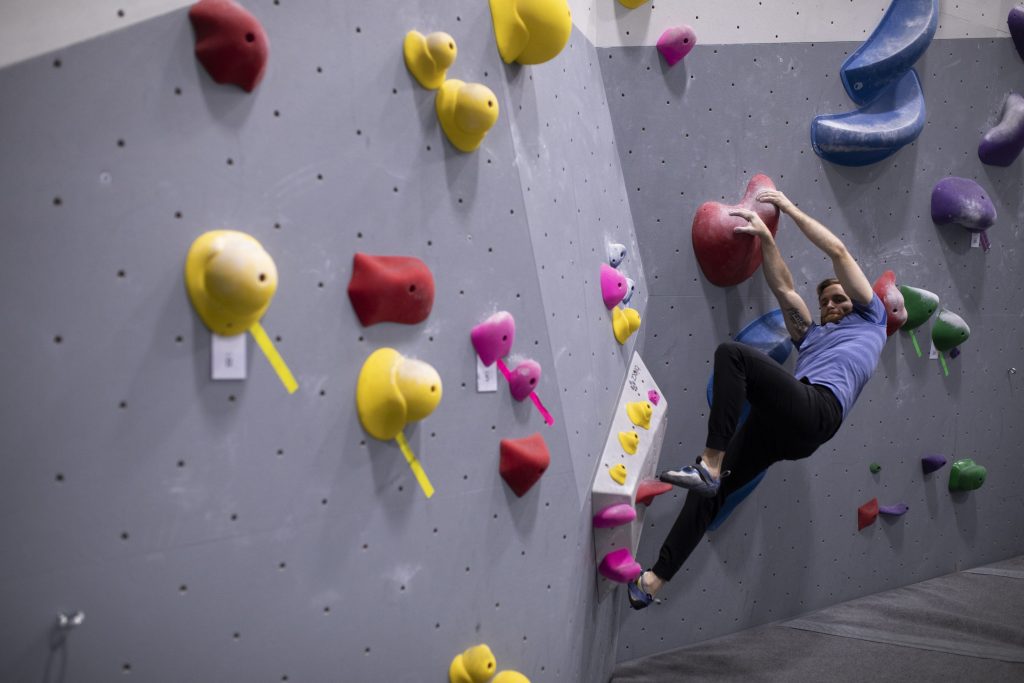
Once again, all of these grades are only to help you understand the route ahead, and they’re not a measure of your abilities. As you gain experience, you’ll notice that some routes with the same grade are not really equal for you – some will seem much easier than their grade, and some much harder. So, take all these grades with a grain of salt.
Climbing Rocks!
There are a variety of different reasons why people decide to take up rock climbing. Some simply enjoy the associated danger – it’s exhilarating, adventurous, and a perfect fit for a thrill-seeker. Some are focused on improving their fitness. Others still are interested in rock climbing for the mental benefits that it brings. Regardless of the reasoning, most people stand to gain something from rock climbing.
Rock Climbing is a Sport, Not Just Exercise – Just ask the Olympic Committee
Rock climbing is a sport, individual, but with team aspects, much like gymnastics. The sport is internationally recognized and has an organized, governing body, the International Federation of Sport Climbing (IFSC). Though the majority of climbers will never take part in a competition, there is a growing trend in indoor competitive rock climbing, and the inclusion of the sport in the 2020 Olympic Games in Tokyo has not only offered legitimacy, but also propelled the sport into the limelight.
Most indoor gyms sponsor youth teams whose members will take part in local, regional, divisional, national, and even international events like the Youth World Championships.
There are 2 basic competitive formats:
- Onsite – climbers compete in climbs they’ve never seen before and without any advice. The climber is quarantined into isolation areas (ISO) prior to his/her turn to prevent viewing other climbers. In sport events, the climber is allowed one attempt and is judged on the highest handhold successfully controlled. In bouldering events, climbers are allowed multiple attempts within a 4-5 min time frame and are scored based on highest point reached and number of attempts.
- Redpoint – all climbs are available for preview to all the climbers at the same time. Climbers can choose which order to climb different routes based on advice from others such as coaches and other climbers. Climbers can receive beta from anyone, but only on the ground, not while climbing. Scores are point based, earned by topping climbs, and ties are broken by fewer attempts.
In bouldering, local, smaller competitions will usually be in redpoint format, but larger, broader comps like regionals and nationals are onsite formats. Sport or roping comps can be in various formats.
Make Gains

Physical exercise can get pretty dull after some time, and anyone who frequents the gym can testify to this. It requires a great deal of motivation, and the results are often not easily noticeable. The result – motivation is easily lost and your new year’s resolution to make gains and shed the muffin top is broken by February.
A sport like rock climbing, on the other hand, can be enjoyed by everyone because it provides both physical and mental stimulation, and it’s easy to get and stay motivated. There are countless skills that need to be acquired, and you’ll always need to improve something, be it your balance, finger strength, core muscle strength, or anything in between. You’ll also have to learn to think on your feet. You have to be focused on what you’re doing at all times, coming up with the best strategies to make the climb, for your safety, and for the safety of those around you.
Switching up your workout routine this way will keep things interesting, and you’ll quickly find yourself getting better day after day.We all know that exercise is crucial if you want to stay healthy and happy, and the best part of rock climbing is that it involves a whole-body workout, head to toes.
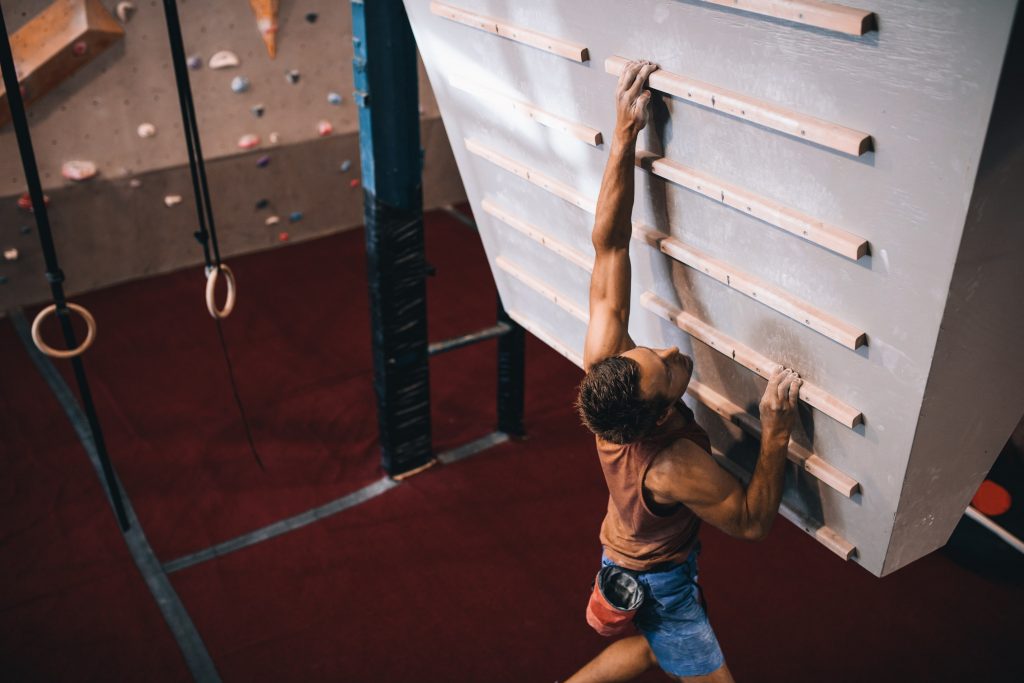
You’ll have to work on your grip to hold onto the rock, your biceps will help pull you up, and your back muscles and lats will work to pull your body toward your hands while keeping your chest close to the wall. Your calves and quads are essential for the climb (don’t skip leg day). Working on your core muscles will help you maintain stability and balance. Even your toes are important, as they have to be able to keep balance on the smallest of surfaces. Not only will this full body workout keep you looking fit, but since it’s essentially a cardio workout as well, it’ll keep your heart healthy.
Make Brains
It isn’t just your muscles that do the work while rock climbing, a big part of succeeding in it comes from the mind. You have to make plans, strategies, decide on the best course of action and all of this requires great mental capacity. More than this, rock climbing is an excellent form of stress-relief, even though this might sound counterintuitive to some. Rock climbing was even shown to be a valid treatment for depression, proving how beneficial it is for mental health, and proving that physical and mental health often go hand in hand.
Yes, it’s stressful at first. Most people are afraid of heights, but during the climb, it’s just you and the rock (or wall). It takes mental strength to face your fears and come out on top, and nothing can match that feeling once you’ve successfully conquered the climb.
Fear of failure is often the main reason why many climbers end up failing and prevents others from even trying. Most beginners worry more about embarrassing themselves than actually falling. Keep in mind that failure is a huge part of this sport – it’s the only way to improve.
When beginning any new sport or any activity for that matter, proficiency is not generally innate. It takes practice and repetition to build the proper strength and technique to succeed. Overcoming that initial embarrassment of failure is part of the learning process.
Take some time to observe other, more experienced climbers. You’ll notice how common failure is, and you’ll see it’s nothing to worry about. Observing others will show how common falls are, and how natural they are to the process.
Make Friends
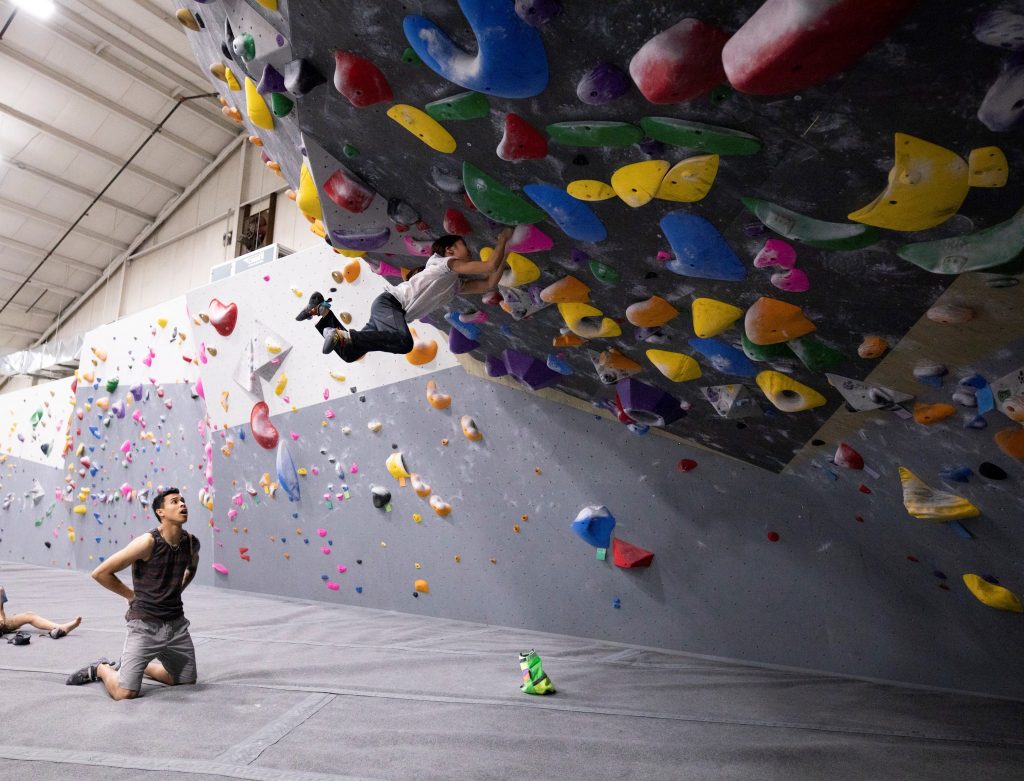
Rock climbing is a highly social sport, and the community has very strong bonds. This is in part due to the nature of the sport. Every climber knows how difficult it can be when it’s just you against the rock (or wall), so they try to be very supportive of each other, always giving advice and encouraging others, especially beginners.
Indoor climbing gyms also offer an alternative to the typical corporate team building or birthday party venues. With plenty of space, excitement, and challenging physical activity, climbing gyms are a great way to bond with coworkers and friends.
Gear Up
Unlike most other sports, rock climbing doesn’t require any specific uniform or apparel. What matters most is that you’re comfortable and that your arms and legs aren’t restricted by the clothes. Good shoes specific to climbing are probably the most important gear, and most gyms will offer adequate shoes to rent.
Once you are more advanced and ready to buy your own, it’s important to invest in quality gear, because, at the end of the day, a good harness, rope, shoes, and belay device might prove to be lifesaving.
Etiquette
Climbers have such a strong reputation for being among the friendliest and most welcoming of communities, but following the proper etiquette is still important. While some improper behaviors simply show a lack of consideration for other climbers, others are hazardous and can put you and others at risk. As in any other community, it takes some time to learn all the do’s and don’ts, and while only a few would judge a newcomer too harshly, coming prepared can help you fit in more easily.
Keep an Eye on Your Surroundings

Most importantly, keep an eye on your surroundings. This doesn’t just mean being attentive while you climb, it means being attentive when others are as well. Ensure that you and/or your belongings are never in the “fall zone” of another climber, as this can be extremely hazardous.
If another climber is already on the wall, don’t interrupt them or be in their way, and be aware of safety equipment. While this advice may seem obvious, most gym injuries occur from a lack of attention to this fundamental detail.
No Wall or Rope Hogging
While there’s no time limit on bouldering walls and ropes, it’s never okay to keep others waiting for too long.
If you need time to rest, or you’re thinking about how to make the climb, do it away from the wall or rope, as it’s very likely that there are others who’d like to use them.
Braggers are a Drag
Your new friends in the rock-climbing community will be more than happy to celebrate your successes with you, and it’s completely fine to be proud of your achievements. However, bragging about all the climbs you’ve made gets old quickly. Take pride in your achievements, then move on.
Wake Up, You’re Belaying!
Rock climbing is an extremely exciting sport – it’s always interesting mastering new moves and techniques, but like any other sport, there are a few aspects that aren’t exciting – like belaying duty. Belaying may not be fun, but it’s so important to remain focused while performing the task; otherwise, your partner can get seriously hurt. Always pay attention to the climber you’re helping, and they’ll do the same for you.
Stop Chalking so Much
Chalk is essential, but know when to chill on the chalk. No one likes bouldering after another climber who’s left way too much chalk on the wall, and it can make the holds slippery.

Make sure to have your own chalk as well. Others won’t mind sharing once or twice, but no one likes a moocher.
The Person Who Brushes – Climbs
A lot of climbers will brush the holds to remove any excess chalk, rubber, or other residues. That way they ensure that the holds are in optimal condition for climbing.
It’s extremely rude to get on a problem while the climber who’s brushed the holds is putting the brush away. If they’ve brushed it, it’s very likely they want to climb there.
Ask for Advice, But Not in the Middle of a Climb
Climbers are very friendly and will share their opinions and advice when asked, but it takes a great deal of concentration to maintain balance and make the climb – you wouldn’t want anyone breaking your focus, so don’t break theirs.
Don’t Offer Unsolicited Advice
If you have some advice for another climber, no matter how helpful you believe it is, make sure that the other climber wants to hear it. Most climbers love figuring out how to overcome obstacles on their own and enjoy that learning process. If they need advice, they’ll ask for it.
Jargon
Like any other sport, rock climbing has its own distinct jargon that takes a while to learn. It’s always a good idea to come prepared, and learn some expressions beforehand, as it’ll be easier to understand what the other climbers are saying, and you’ll be able to heed their advice more quickly.
Beta
Seeing how approachable and friendly the rock-climbing community is, you’ll be sure to get a lot of beta on your first day. Beta is information – it refers to any details, advice, information, tricks, or equipment placement regarding a climb.
Send/Top/Topping out
Send/top/topping out will no doubt leave you with a sense of accomplishment and a smile on your face. It refers to completing a route without falling, and without resting on gear.
Belay
Belaying is what you need to pay very close attention to. It’s any of the techniques that climbers use to prevent the climber from falling down very far. It’s accomplished by using friction on the rope.
For proper belaying, you’ll need rope, anchors, a belay device, the belayer itself, and, of course, your full attention.
Pumped
If you’re pumped, it means that your muscles are filled with lactic acid, and they’ve become bloated. When this happens, even a basic grip is next to impossible to perform. Climbers who are pumped cannot hold on, and can even struggle to lift or clip a rope.
There are many techniques that can help you avoid and manage getting pumped, but if it happens to you, it’s best to take some time to rest and heal.
Flash
Flash is very similar to send/top. It means a clean ascent of a climb on the first attempt, but only after getting some advice beforehand, or beta, or having the equipment already in place.
On Site / On Sight
Like send, on site, or on sight, means successfully climbing a route from bottom to top, in one continuous flow and on the first attempt (and seeing it for the first time), without receiving any prior beta. This also includes placing all your own equipment and clipping the bolts, all without resting on the ropes and, of course, without falling.
Dyno
Dyno, or dynamic motion, is usually a jump, or what non-climbers would call a leap. This means that the climber has to jump, losing all contact with the rock, to gain a distant hold.
Smear
Smearing is your only option when there are no useful footholds anywhere around you. It means pushing your feet against the wall instead of against footholds, and creating friction with the sole of your climbing shoe in order to ascend.
Crux
The crux is the most difficult move on a climb, or simply the hardest part of the route.
There are countless more phrases and terms you’ll learn while rock climbing, but this list will be just enough to get you started.
Different Holds
You’ll need to master a variety of different moves and holds as you progress as a climber. Learning the names of different holds and how they look is essential, as it’ll help you spot them and understand how to grab on to them.
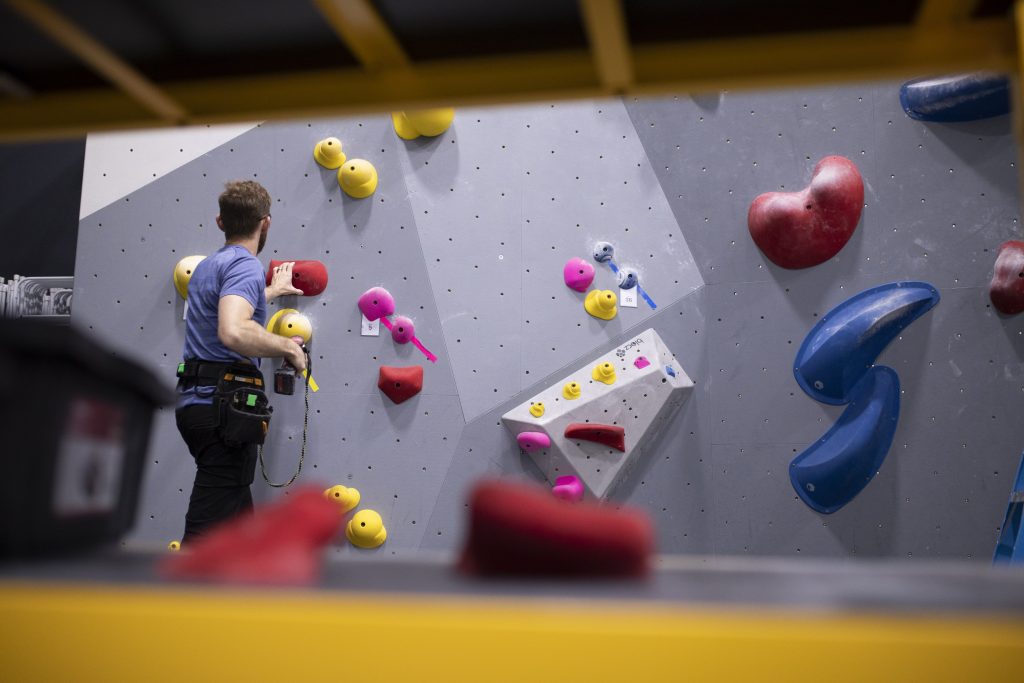
Crimps
Crimps are the classic holds that come to mind when you think of rock climbing. They’re a rather small edge where you can place only the pads of your fingertips rather than the whole hand.
You need to get your body as close to the wall as possible to get a good hold of a crimp. You need to be careful with crimps – holding on to them can cause stress on your finger tendons.
Slopers
Slopers are usually larger holds that don’t actually have a positive edge, so there’s nothing for you to grip. They’re more difficult to master, as you have to rely on the friction of your fingertips against the hold to pull yourself up.
Make sure to have enough chalk on your hands when you attempt to use a sloper.
Sidepulls
Sidepulls are edges that are positioned either vertically or diagonally and are located on your side, rather than above you. To make use of them, you have to pull sideways, rather than downwards.
You’ll also need to make sure to lean in the opposite direction of the sidepull in order to counterbalance yourself. That is, if the sidepull is on your right, you’ll need to lean to your left to maximize the opposition and make a higher reach with your free hand.
Gastons
Gastons, named after the French alpinist Gaston Rébuffat, are somewhat similar to sidepulls, but involve pushing instead of pulling – with the thumbs facing down, you push against the hold to create friction. Imagine trying to manually open elevator doors.
Pinches
A pinch is any hold that you have to, well, pinch with your fingers on one side of it, and your thumb on the other. They’re normally positioned vertically, as they could be used as crimps or slopers otherwise.
Underclings
As the name implies, an undercling is a hold that you have to grip on its underside. They’re notoriously difficult to hold when they’re well above your head, and they work best when located somewhere near your mid-section.
There are many other types of holds that you’ll encounter while rock climbing and most of them require different climbing techniques. As you progress, it’ll become easier to hold on to them.
Jugs
Generally large size holds, jugs are often large enough for both hands and used for resting or clipping.
Pockets
Similar to jugs, but instead the climbing grip surface is inside the hold itself rather than outside.
And I’m Free, Free Falling
Falling is a huge part of the sport, and there’s no avoiding it, so it’s essential that you’re always prepared for a fall.
You need to learn how to fall “correctly” to avoid any major injuries. You must overcome your fear of failure, and you must gain knowledge and experience which will prevent you from panicking or freezing.
Falling Safely (yes, there is such a thing)
A common credo in the climbing community is “If you aren’t falling, you aren’t trying hard enough.” To advance as a climber, you’ll have to fall more often than you’d like.
Even in controlled environments like the gym, landing from a fall at the wrong angle or too stiffly can cause injuries. There are a few things you need to do to ensure your falls are safe:
- Keep your arms relatively close to your body, but not stiff. Keeping your arms in will minimize scrapes, and you’ll be able to balance yourself better.
- Bend your knees. If you tighten up, you risk breaking a bone upon impact. Keep your knees slightly bent so that you’ll be able to absorb the impact more efficiently.
- Roll onto your back to help break your fall and minimize injuries by dissipating the kinetic energy across a larger part of your body.
- Practice. Start small and practice falling from heights that you’re comfortable with. Move up from there, and practice frequently – you’ll quickly get used to falling both physically and mentally.
Basic Climbing Technique
Like every other sport, rock climbing looks easier than it actually is. It takes a lot of practice not only to master the more complicated moves but simply to hold on to a rock that’s only 5 feet up.
With a good climbing technique, though, you won’t get pumped, and you’ll be able to keep your strength and climb more efficiently. Don’t get frustrated if even the simpler techniques don’t come as easily to you. Give yourself time to improve.
Use Your Lower Body
The most common mistake most rock-climbing beginners make is relying on their hands and arms too much. While it’s necessary to work on your upper body strength, your lower body is much more important for climbing, simply because your legs are naturally much stronger than your arms.
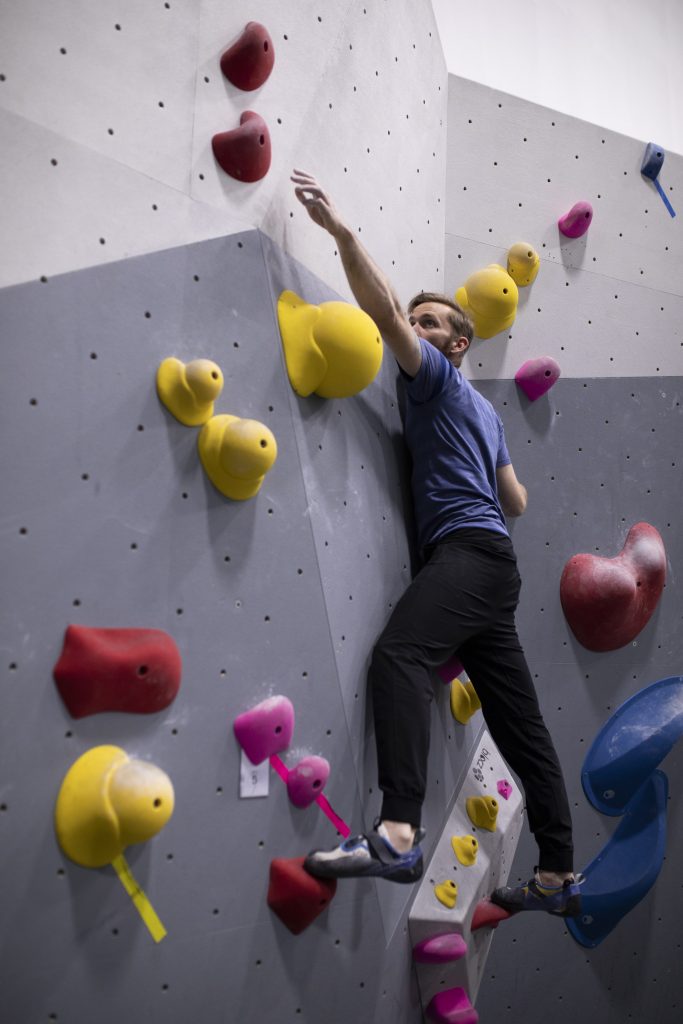
Instead of using your arms to pull yourself up, rely on your legs to do the work and push you up. If you get stuck during a climb, instead of searching for places where you can put your hands, look at your feet, and try to move them to a higher position.
Good footwork is crucial to becoming a successful rock climber. You need to practice your precision, and have good coordination, always being aware of where your feet are located.
Your Hips Don’t Lie – Keep ‘em Close to the Wall
The second basic technique you need to master is keeping your hips as close to the wall as possible. The farther away your hips are from the wall, the more you’ll need to rely on your arms and fingers which will cause you to tire out much faster.
Relax the Kung Fu Grip
You shouldn’t be using your arms to pull yourself up unless absolutely necessary. You should be using them primarily to pull yourself into the wall and maintain balance, rather than to pull up the wall. Keep in mind that your legs should be doing most of the work, otherwise you risk injuring your arms and fingers.
When climbing, use a relaxed grip and try to keep your arms straight to conserve energy, and use your lower body for most of the work. To hold on with bent arms arms you expend more energy by engaging your biceps, back, and shoulder muscles.
Preventing Climbing Injuries
Rock-climbing injuries are inevitable, particularly the minor ones like blisters and sore muscles. However, with preparation, you can prevent any major injuries.
Warm up before a climb, rest when needed, and listen to your body when it’s telling you to take a break.
Warm up Properly
Before any type of workout, you should always ensure your muscles are ready with the proper warm up. Climbing a very easy route will get your blood pumping and will ensure that your muscles are ready for more complex climbs.
Dynamic stretching is one of the most effective ways to warm up properly. By taking muscles through a full range of motion, stiffness is reduced by increasing blood circulation. Make sure to spend at least 10 minutes stretching and warming up before attempting a climb.
Rest Between Climbing Days – Even God Did
Overuse injuries are sustained from excessive repetitive action, and are some of the most common climbing related injuries. Your rest days are just as important as your climb days, so give yourself enough time to rest and recharge.
When you first start rock climbing, one or two training days a week are enough, and even as you progress, you should give yourself at least 2 days a week to rest.
Listen to Your Body – it’s a Temple
If you feel any pain in any part of your body while climbing, it’s much better to give yourself some extra time for a break than to push through the pain.
Your body will feel sore even with ample time for rest, so if your body is telling you to take an extra day or two to recover, listen to it. This will ensure that every time you climb, you’re doing your best, and will help you avoid injuries. Usually, climbers take about 2 days to rest after a difficult climb, but that all depends on the individual and on the type of soreness or pain they’re experiencing.

Managing Injuries
It should be noted that if you sustain any serious injuries, or you’re experiencing pain that doesn’t seem to go away, you should visit a doctor or health care practitioner. For most minor soft tissue injuries, such as sprains or strains, the RICE treatment will work wonders. That’s short for Rest, Ice, Compression, and Elevation.
Ice, Ice, Baby
Icing works by limiting the blood flow to the injured area. When the area is cooled down, the veins get narrower, and blood cannot flow as smoothly or as quickly which reduces inflammation and pain.
Be careful here, however. While icing will reduce the pain, it can slow down the healing process, as good blood flow is crucial for the injured area to heal. A good practice would be to limit ice to your injury to about 20 minutes per hour. This will allow you to reduce the inflammation and pain while still providing enough blood flow for the injury to heal.
Rest is Best
While most climbers don’t want to hear this, it’s still true – rest IS the best healer. We’ve already discussed how it can prevent injuries, but it’s crucial for managing them as well. If you don’t allow enough time for the injury to heal, you risk making it worse.
Check with your doctor or physiotherapist, and heed their advice. If they tell you that you should rest, do it. If you’re anxious to go back to rock climbing, start small. Until your injury is fully healed, you shouldn’t be doing anything too physically demanding.
Summit Up
Rock climbing may not be for everyone, but those looking for excitement and adventure will find it exceptionally enjoyable. It’s a holistic sport that’s beneficial for your body and mind, and the friendly community will make you feel accepted and welcomed from the moment you step into the gym.
Beginners often have a hard time getting used to any sport, but a bit of research and the plentiful beta we’ve provided will set you on the path to success. Continued practice will help you gain confidence, strength, and focus while reducing fear, stress, and boredom.
